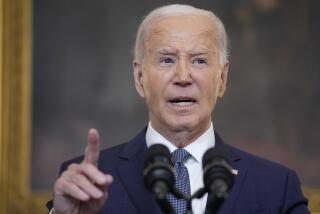New Soviet Plan May Delay Arms Pact : Moscow Wants Warheads Removed First, Missiles Scrapped Later
- Share via
GENEVA — The Soviet Union has made a new arms reduction proposal that threatens to further delay the successful conclusion of the nuclear arms negotiations, it was learned here Wednesday.
Under the terms of the two-step Soviet proposal, all nuclear warheads would be removed from medium- and short-range missiles worldwide and scrapped, then the missiles would be retired and destroyed at a later stage.
The United States is strongly opposed to this Soviet approach and is insisting that the missiles and warheads be removed and destroyed simultaneously on an agreed step-by-step timetable with continuous verifications, inspections and controls. If the issue is not resolved here in the next two weeks, it is likely to be a major topic when Secretary of State George P. Shultz meets Soviet Foreign Minister Eduard A. Shevardnadze in Washington on Sept. 17.
Nevertheless, according to well-informed sources at the talks, the outlook for early agreement is good, with the general outlines of an extensive “verification package” now in place. Among the details to be resolved at the Shultz-Shevardnadze meeting will be the following:
--The time frame of the new arms reduction treaty. It now seems likely that the missiles will be removed across a period of three years from the time the treaty goes into effect until the last missile is gone. The verification and inspection procedures will remain in force for a much longer period.
--Agreement on a step-by-step phasing of missile withdrawal on both sides. According to the International Institute for Strategic Studies, the Soviet Union will be withdrawing 683 launchers and the United States 415 so far deployed. Agreement is yet to be reached on a timetable of reductions that would maintain a balance as the numbers shrink.
--Agreement on data and numbers. The published figures available through the institute and other agencies are not necessarily the same as might be found in secret intelligence estimates. As yet, the Soviet Union has not formally stated how many missiles it has and how many, therefore, it will be retiring and destroying. There will have to be mutually agreed-on data before there can be any workable reduction agreement.
--Agreement on exactly what and where sites, installations and military-related facilities will be opened up for inspection and verification and control. At the moment, the Soviet Union has proposed to open up on-site inspections that could be even stretched to include American bases at Guantanamo Bay in Cuba or Subic Bay in the Philippines.
--Agreement on a procedure for quick, random on-site inspections of missile-related facilities on short notice. If, for example, a satellite photo shows some movement of missile launchers that alters the deployment pattern, then each side must have the right to a rapid look at the site.
--Agreement on the organization, staffing and location of a permanent Soviet-American headquarters or commission to monitor the arms reduction treaty on a round-the-clock basis at least through the initial three-year period of missile withdrawal and destruction.
According to sources familiar with the agreement taking shape, there will be four layers of verification and control and inspection.
More to Read
Sign up for Essential California
The most important California stories and recommendations in your inbox every morning.
You may occasionally receive promotional content from the Los Angeles Times.













